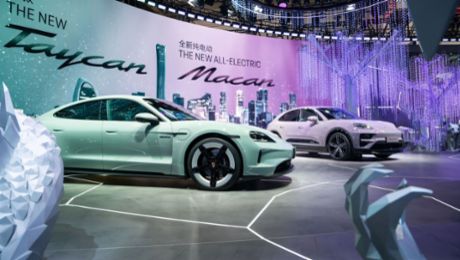Naturally aspirated engine, lightweight clutch, manual transmission
The emotive and technological highlight of the 911 S/T is its powertrain. The naturally aspirated, 4.0-litre, 386 kW (525 PS) flat-six engine is based on a motorsport development only minimally modified for use on the road. The familiar six-cylinder engine from the 911 GT3 RS (911 GT3 RS: Fuel consumption* combined (WLTP) 13.4 l/100 km, CO₂ emissions* combined (WLTP) 305 g/km, CO2 class G ) has six individual throttle valves, a dry-sump lubrication system, a 9,000 rpm rev limit and an incomparably intense character. For the first time – and exclusively in the 911 S/T – the engineers have coupled the engine to a manual six-speed transmission. In doing so, they have heightened the connection between the driver and the vehicle and created a particularly direct driving experience. They also equipped it with a lightweight clutch and a single-mass flywheel.
Porsche has developed the clutch and flywheel exclusively for the 911 S/T. Compared to the corresponding standard components, they save 10.5 kg. Engineers have used these measures to increase the rotational speed of the powertrain: this weight-loss regime in the bell housing reduces the overall inertia in the drivetrain. It allows the flat-six engine to rev up more freely and easily. The 911 S/T has also taken its six-speed manual transmission from the 911 GT3 Touring. For the new, road-focused GT sports car, Porsche has cut the final drive ratio by eight per cent. With the modified gear ratio and the reduced rotating masses, the result is greater responsiveness in every gear. The car accelerates more quickly and with noticeably enhanced dynamics.
“The 911 S/T moves forward with tremendous power and verve. It feels even faster than it already is,” says motorsport legend Walter Röhrl. The 911 S/T reaches 100 km/h in just 3.7 seconds. The top speed is electronically limited to 300 km/h.
The iconic naturally aspirated engine reaches its maximum torque of 465 Nm at 6,300 rpm and its maximum power output of 386 kW (525 PS) at 8,500 rpm. High engine speeds of up to 9,000 rpm mean high demands on the engine’s valvetrain. Unlike most series production engines, the motorsport-inspired engine in the 911 S/T therefore dispenses with hydraulic valve clearance compensation. Porsche uses rigid rocker arms and adjusts the valve clearance once during production of the unit with interchangeable shims. Later correction is not necessary. This allows the four-valve cylinder heads to withstand the high engine speeds. Furthermore, forged pistons, titanium connecting rods and dry-sump lubrication with a fully variable pressure pump, seven suction stages and an additional oil supply via the crankshaft ensure stability at high piston and cornering speeds. A plasma coating on the cylinder walls reduces internal engine friction. The lightweight stainless steel exhaust system contributes a rich and powerful sound. The auto start/stop function is also omitted in the 911 S/T.



